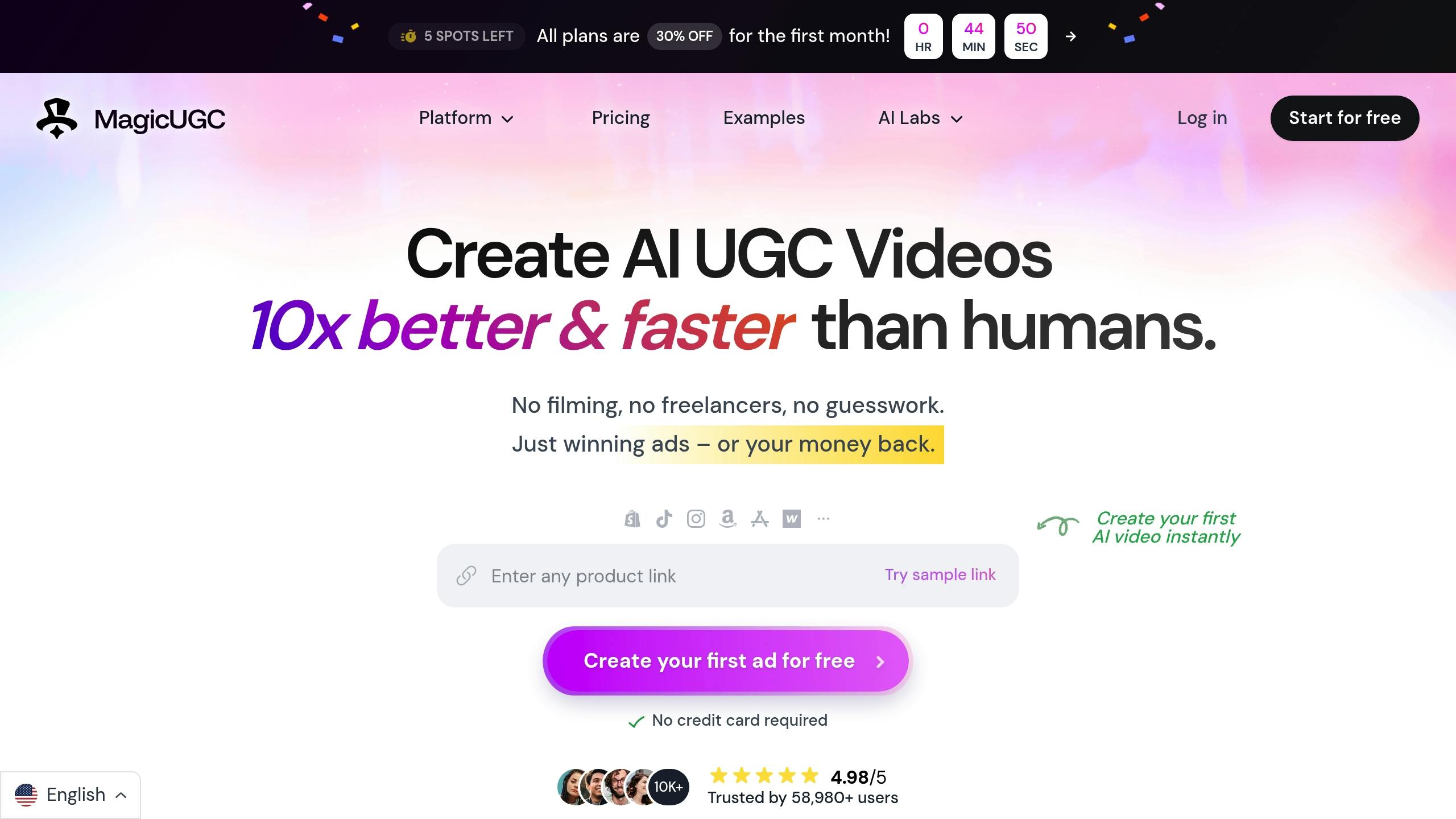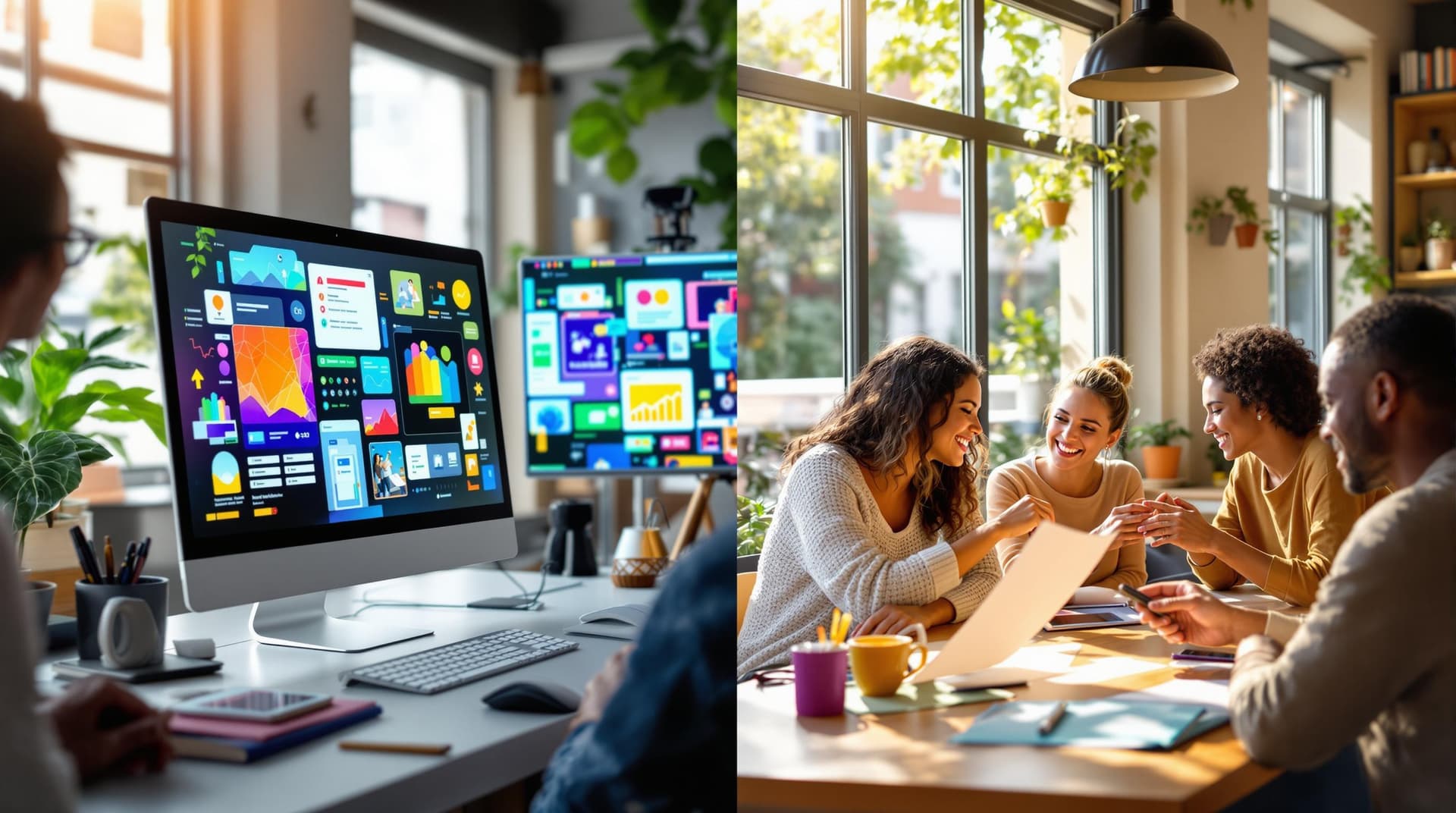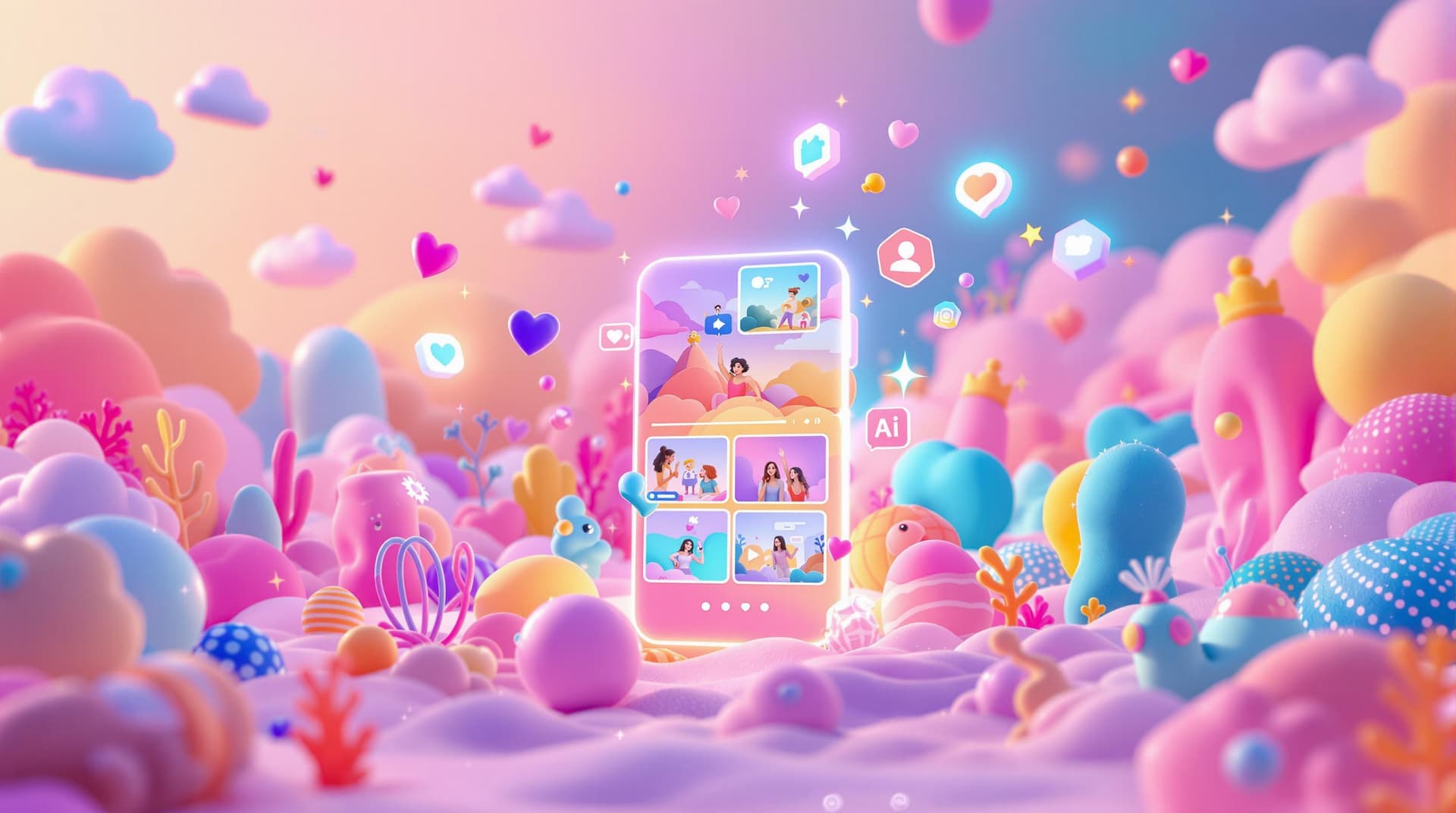
AI influencers and AI-generated user content (UGC) are reshaping marketing and storytelling. Here's what you need to know:
- What are AI influencers? Virtual personalities like Lil Miquela and Lu do Magalu that engage audiences 24/7 with consistent branding.
- Why brands use AI UGC: Cost-effective, scalable, and engaging - AI influencers achieve higher engagement rates (2.84%) than human influencers (1.72%).
- Examples of success: Dell increased conversions by 45% using AI, and Coca-Cola created interactive campaigns blending AI and user creativity.
- Key challenges: Transparency and trust are critical. Brands must disclose AI use and balance it with human creativity.
- Future trends: AI tools are advancing personalization, multilingual content, and hyper-realistic avatars, transforming marketing strategies.
AI is rapidly becoming a cornerstone of content creation, offering efficiency and personalization while raising ethical and creative questions.
AI Influencers: The Rise of Virtual Content Creators
AI's Impact on Content Creation
AI tools are transforming how user-generated content (UGC) is created, offering speed and scalability. Marketers can now produce content that connects with audiences while ensuring consistency across different platforms.
Benefits of AI-Generated Content
AI tools can cut content creation time in half, saving about an hour per piece . Subscriptions often cost less than $100 a year , making them a budget-friendly solution. Tools like AI Composer have been shown to improve post performance by 5% and boost Instagram engagement by nearly 9% . Personalization is another key strength, with 60% of consumers more likely to become repeat buyers when they experience tailored content .
Leading companies are already leveraging AI for personalization:
"As the demand for engaging and timely content continues to rise, AI is becoming an essential tool for content creators across various industries. By streamlining their processes and freeing up more time for creative strategy, AI empowers content creators to focus on what truly matters - crafting impactful messages that resonate with their audiences." – Susan Ganeshan, Emplifi CMO
These tools have proven their value in real-world campaigns executed by top brands.
Examples of AI-Driven UGC Success
Several brands have achieved impressive results using AI-powered UGC campaigns:
- Dell: By using Persado's AI to personalize marketing copy across emails, ads, and radio, Dell saw a 45% increase in conversions across these channels .
- Indochino: With Qubit's AI-powered website personalization, Indochino generated $1 million in additional revenue by tailoring experiences for different customer groups .
- Reebok: The "Reebok Impact" campaign let users design digital sneakers with AI-generated patterns, which they could share or purchase on platforms like Unreal Editor for Fortnite and Roblox .
- Coca-Cola: The "Create Real Magic" campaign allowed consumers to use AI tools to design creations with Coca-Cola branding, blending user creativity with the brand's identity .
Ethics and Risks of AI Influencers
As AI reshapes content creation, it's equally important to examine its ethical impact. The use of AI by influencers is growing rapidly - 76% of agencies and 52% of influencers now incorporate it into their work . This raises questions about consumer trust and the evolving role of human creativity in the influencer space.
Disclosure and Trust Issues
Being transparent is non-negotiable. A staggering 94% of marketers believe that transparency is key to success, while 93.8% of consumers expect clear disclosure when AI is involved . It's fine to push boundaries with AI, but honesty about its use is essential.
"AI definitely doesn't represent the complexity, heterogeneity and diversity of cultures", says Sasha Luccioni, a researcher at Hugging Face specializing in ethical AI .
Impact on Human Creators
While transparency helps maintain trust, overusing AI could sideline human creativity. Relying too heavily on AI risks diluting the authenticity and individuality that human influencers bring to storytelling. Striking a balance - where AI complements rather than overshadows human input - is crucial to preserving meaningful, narrative-driven content.
Legal Requirements and Rules
The Federal Trade Commission (FTC) has laid out specific guidelines for AI-generated content in marketing. Violating these rules can lead to fines of up to $50,120 per instance as of 2023 . Here's what brands need to know:
-
Transparency Rules
Any content created or influenced by AI must clearly state this, including endorsements and ads. -
Consumer Protection Laws
Norway's Marketing Act requires labeling of altered content, particularly when it promotes unrealistic body standards . -
Compliance Measures
Brands should implement key practices like:- Regular audits of AI-generated content
- Clear and consistent disclosure policies
- Documenting AI system decisions and updates
- Training marketing teams on ethical AI use
sbb-itb-d822133
Using AI UGC Effectively
Using AI-generated content successfully requires a mix of automation and human expertise. Nearly 60% of marketers have seen better results by incorporating AI into influencer marketing . To make the most of these tools, it's important to strike the right balance.
Combining AI and Human Input
The "Human – AI – Human" method ensures that humans stay in control of strategy and creativity, while AI handles repetitive tasks like bulk content creation and optimization .
Here’s how it works:
-
Strategic Planning (Human)
Start by defining your audience, key messages, and goals before involving AI tools. -
Content Generation (AI)
Use AI to manage repetitive tasks and create initial drafts. For instance, YouTube has seen a 70% rise in AI-assisted content creation . -
Refinement (Human)
Add emotional depth, cultural context, and brand-specific details to AI-generated content. This step addresses concerns about authenticity, which 36.7% of marketers still worry about .
Making the Most of MagicUGC

MagicUGC offers tools designed to create high-conversion UGC videos. Here’s how you can use its features effectively:
| Feature | Best Practice | Impact |
|---|---|---|
| AI Persona Targeting | Align avatars with your target audience | Improves audience connection |
| Brand DNA Scanner | Add brand guidelines and tone preferences | Ensures consistent messaging |
| Viral Content Templates | Start with templates, then customize | Boosts engagement opportunities |
Preserving Your Brand Voice
Keeping your brand voice intact while using AI tools requires extra care . Here are some helpful tips:
- Document your brand’s voice: Clearly outline your tone, style, and personality.
- Provide detailed prompts: Give AI specific instructions that reflect your brand identity.
- Perform regular quality checks: Review AI-generated content to ensure it meets your standards .
Brands using AI in advertising have seen 15-25% higher engagement rates . This shows how a thoughtful mix of human and AI efforts can elevate your content strategy.
What's Next for AI Content
AI's role in content creation and audience engagement is set to grow even more. McKinsey estimates that AI could contribute $4.4 trillion annually through productivity improvements .
New AI Marketing Tools
AI is driving progress in content creation with tools that are reshaping how marketers work:
| Tool Category | Current Development | Expected Impact |
|---|---|---|
| Content Automation | User-friendly, specialized tools | Faster and more efficient content creation |
| Multilingual Support | AI-driven dubbing and translation | Easier access to global markets |
| Creative Generation | AI-generated images and music | Lower production costs and quicker turnaround |
For example, Creatify's AI-powered video ads deliver 2.7x more leads and a 1.7x higher ROI compared to traditional image-based ads . These tools are also fueling the rise of hyper-realistic AI personas, which are reshaping influencer marketing.
Future of AI Influencers
The concept of virtual influencers is gaining traction. More than half of marketers (52.8%) believe AI-driven personalities will play a major role in the future of marketing .
"AI will not replace content creators. Instead, leading content creators will use it as a powerful collaborator, automating tasks, fueling creativity, and providing data-driven insights."
The AI in Social Media Market is expected to grow at a CAGR of 36.2% by 2029 , thanks to advancements like:
- Improved Realism: AI avatars now feature lifelike lip-syncing and emotional expressions.
- 24/7 Availability: AI influencers can engage audiences across platforms nonstop.
- Customization: Brands can fine-tune AI personas to align with specific market goals.
Changes in Customer Relations
AI is also transforming how brands interact with their audiences. Currently, 14% of sales and marketing professionals regularly use generative AI .
-
Content Personalization
AI tools allow brands to analyze audience preferences and create highly targeted content at scale. -
Maintaining Trust
With AI content on the rise, ensuring genuine connections with audiences is more important than ever.
"The best thing about Creatify is that when AI avatars speak, their lip-syncing and overall realism are very strong... It wasn't until we used Creatify that we felt AI avatars could be a long-term solution."
- Evolving Content Creation
Goldman Sachs predicts the content creator industry will reach $500 billion by 2027 . This shift is leading to "Content Creation Centaurs", where human creativity pairs with AI's analytical power .
AI could add $400-500 billion in value to the marketing industry , reshaping how brands connect with audiences while keeping human interaction at the core.
Conclusion
AI influencers and AI-generated user-generated content (UGC) are transforming how brands tell their stories online. UGC campaigns have proven their power, boosting web conversions by up to 161% , with 87% of businesses now using UGC to share content that resonates .
"Integrating AI into user-generated content (UGC) campaigns has been a game-changer. AI tools streamline content curation and offer predictive insights, suggesting what type of content will resonate best with our audience."
For businesses looking to implement AI-powered UGC effectively, focusing on key strategies is critical:
| Success Factor | Implementation Strategy | Expected Outcome |
|---|---|---|
| Transparency | Clearly disclose AI involvement in content creation | Build trust with 73% of online adults who value transparency in AI usage |
| Human-AI Balance | Combine AI's efficiency with human creativity | Deliver high-quality content while keeping a human touch |
| Data-Driven Approach | Leverage AI analytics for optimization | Achieve higher engagement and conversion rates |
These strategies highlight the importance of a thoughtful mix of AI and human input.
William Gasner from Stack Influence emphasizes the importance of this balance:
"The key for marketers using AI-generated content is to carefully blend it together with authentic UGC to maintain authenticity and trust among consumers. AI content initiatives need to complement rather than contradict the human element that lies at the heart of marketing content."
Still, challenges remain. A recent study revealed that 85% of marketing agencies lack expertise in managing multi-AI systems . Tools like MagicUGC are stepping in to simplify AI-driven content creation with features like script optimization and audience targeting. Yet, authenticity remains a top priority, as 90% of consumers value genuine brand engagement .
The potential for AI in UGC campaigns continues to grow. As Samantha Lopez, Content Marketing Expert at TrendWave Agency, explains:
"Incorporating AI into our UGC campaigns has revolutionized how we personalize user interactions. By leveraging AI algorithms, we can tailor content to individual user preferences and behaviors, creating a more immersive and engaging experience."



